Related Research Articles
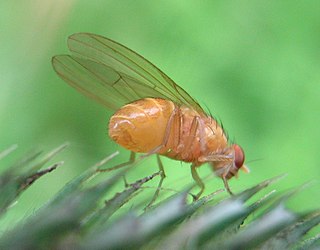
Biology – The natural science that studies life. Areas of focus include structure, function, growth, origin, evolution, distribution, and taxonomy.
Morphogenesis is the biological process that causes a cell, tissue or organism to develop its shape. It is one of three fundamental aspects of developmental biology along with the control of tissue growth and patterning of cellular differentiation.

A biofilm is a syntrophic community of microorganisms in which cells stick to each other and often also to a surface. These adherent cells become embedded within a slimy extracellular matrix that is composed of extracellular polymeric substances (EPSs). The cells within the biofilm produce the EPS components, which are typically a polymeric combination of extracellular polysaccharides, proteins, lipids and DNA. Because they have a three-dimensional structure and represent a community lifestyle for microorganisms, they have been metaphorically described as "cities for microbes".

Biological control or biocontrol is a method of controlling pests, whether pest animals such as insects and mites, weeds, or pathogens affecting animals or plants by using other organisms. It relies on predation, parasitism, herbivory, or other natural mechanisms, but typically also involves an active human management role. It can be an important component of integrated pest management (IPM) programs.
In biology, quorum sensing or quorum signaling (QS) is the ability to detect and respond to cell population density by gene regulation, typically as a means of acclimating to environmental disadvantages. Quorum sensing is a type of cellular signaling, and more specifically can be considered a type of paracrine signaling. However, it also contains traits of autocrine signaling: a cell produces both the autoinducer molecule and the receptor for the autoinducer. As one example, QS enables bacteria to restrict the expression of specific genes to the high cell densities at which the resulting phenotypes will be most beneficial, especially for phenotypes that would be ineffective at low cell densities and therefore too energetically costly to express. Many species of bacteria use quorum sensing to coordinate gene expression according to the density of their local population. In a similar fashion, some social insects use quorum sensing to determine where to nest. Quorum sensing in pathogenic bacteria activates host immune signaling and prolongs host survival, by limiting the bacterial intake of nutrients, such as tryptophan, which further is converted to serotonin. As such, quorum sensing allows a commensal interaction between host and pathogenic bacteria. Quorum sensing may also be useful for cancer cell communications.

Aphids are small sap-sucking insects and members of the superfamily Aphidoidea. Common names include greenfly and blackfly, although individuals within a species can vary widely in color. The group includes the fluffy white woolly aphids. A typical life cycle involves flightless females giving live birth to female nymphs—who may also be already pregnant, an adaptation scientists call telescoping generations—without the involvement of males. Maturing rapidly, females breed profusely so that the number of these insects multiplies quickly. Winged females may develop later in the season, allowing the insects to colonize new plants. In temperate regions, a phase of sexual reproduction occurs in the autumn, with the insects often overwintering as eggs.
An agent-based model (ABM) is a computational model for simulating the actions and interactions of autonomous agents in order to understand the behavior of a system and what governs its outcomes. It combines elements of game theory, complex systems, emergence, computational sociology, multi-agent systems, and evolutionary programming. Monte Carlo methods are used to understand the stochasticity of these models. Particularly within ecology, ABMs are also called individual-based models (IBMs). A review of recent literature on individual-based models, agent-based models, and multiagent systems shows that ABMs are used in many scientific domains including biology, ecology and social science. Agent-based modeling is related to, but distinct from, the concept of multi-agent systems or multi-agent simulation in that the goal of ABM is to search for explanatory insight into the collective behavior of agents obeying simple rules, typically in natural systems, rather than in designing agents or solving specific practical or engineering problems.
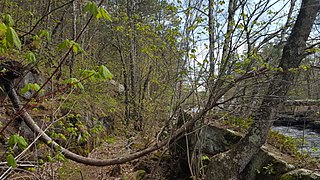
Gravitropism is a coordinated process of differential growth by a plant in response to gravity pulling on it. It also occurs in fungi. Gravity can be either "artificial gravity" or natural gravity. It is a general feature of all higher and many lower plants as well as other organisms. Charles Darwin was one of the first to scientifically document that roots show positive gravitropism and stems show negative gravitropism. That is, roots grow in the direction of gravitational pull and stems grow in the opposite direction. This behavior can be easily demonstrated with any potted plant. When laid onto its side, the growing parts of the stem begin to display negative gravitropism, growing upwards. Herbaceous (non-woody) stems are capable of a degree of actual bending, but most of the redirected movement occurs as a consequence of root or stem growth outside. The mechanism is based on the Cholodny–Went model which was proposed in 1927, and has since been modified. Although the model has been criticized and continues to be refined, it has largely stood the test of time.

The Aphididae are a very large insect family in the aphid superfamily (Aphidoidea), of the order Hemiptera. These insects suck the sap from plant leaves. Several thousand species are placed in this family, many of which are considered plant/crop pests. They are the family of insects containing most plant virus vectors with the green peach aphid being one of the most prevalent and indiscriminate carriers.
Microbial intelligence is the intelligence shown by microorganisms. The concept encompasses complex adaptive behavior shown by single cells, and altruistic or cooperative behavior in populations of like or unlike cells mediated by chemical signalling that induces physiological or behavioral changes in cells and influences colony structures.

The Russian wheat aphid is an aphid that can cause significant losses in cereal crops. The species was introduced to the United States in 1986 and is considered an invasive species there. This aphid is pale green and up to 2 mm long. Cornicles are very short, rounded, and appear to be lacking. There is an appendage above the cauda giving the aphid the appearance of having two tails. The saliva of this aphid is toxic to the plant and causes whitish striping on cereal leaves. Feeding by this aphid will also cause the flag leaf to turn white and curl around the head causing incomplete head emergence. Its host plants are cereal grain crops including wheat and barley and to a lesser extent, wild grasses such as wheatgrasses, brome-grasses, ryegrasses and anything in the grass family.

A prokaryote is a single-cell organism whose cell lacks a nucleus and other membrane-bound organelles. The word prokaryote comes from the Ancient Greek πρό 'before' and κάρυον 'nut, kernel'. In the two-empire system arising from the work of Édouard Chatton, prokaryotes were classified within the empire Prokaryota. But in the three-domain system, based upon molecular analysis, prokaryotes are divided into two domains: Bacteria and Archaea. Organisms with nuclei are placed in a third domain, Eukaryota.
FORECAST is a management-oriented, stand-level, forest-growth and ecosystem-dynamics model. The model was designed to accommodate a wide variety of silvicultural and harvesting systems and natural disturbance events in order to compare and contrast their effect on forest productivity, stand dynamics, and a series of biophysical indicators of non-timber values.
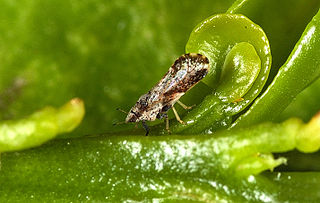
Diaphorina citri, the Asian citrus psyllid, is a sap-sucking, hemipteran bug in the family Psyllidae. It is one of two confirmed vectors of citrus greening disease. It has a wide distribution in southern Asia and has spread to other citrus growing regions.
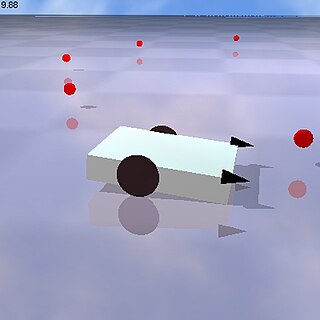
Artificial life is a field of study wherein researchers examine systems related to natural life, its processes, and its evolution, through the use of simulations with computer models, robotics, and biochemistry. The discipline was named by Christopher Langton, an American theoretical biologist, in 1986. In 1987, Langton organized the first conference on the field, in Los Alamos, New Mexico. There are three main kinds of alife, named for their approaches: soft, from software; hard, from hardware; and wet, from biochemistry. Artificial life researchers study traditional biology by trying to recreate aspects of biological phenomena.
Pemphigus betae, also known as the sugarbeet root aphid, is a species of gall-forming aphid that forms galls specifically on the commonly found narrowleaf cottonwood, Populus angustifolia. Sugarbeet root aphids have been found in North America and Europe. They infect sugarbeets, but also other plants like tablebeets and Swiss chard. Their size has been likened to that of a pinhead, and are pale white-yellow in color. Sugarbeet root aphids have soft bodies that are bulbous in shape, with mandibular parts that can pierce and suck and paired abdominal tubes that point backwards, and come in both winged and wingless forms. They are known for their consequential effects on agriculture due to infestation of plants, and efforts to control the pests have proved to be difficult.
Hamiltonella defensa is a species of bacteria. It is maternally or sexually transmitted and lives as an endosymbiont of whiteflies and aphids, meaning that it lives within a host, protecting its host from attack. It does this through bypassing the host's immune responses by protecting its host against parasitoid wasps. However, H. defensa is only defensive if infected by a virus. H. defensa shows a relationship with Photorhabdus species, together with Regiella insecticola. Together with other endosymbionts, it provides aphids protection against parasitoids. It is known to habitate Bemisia tabaci.
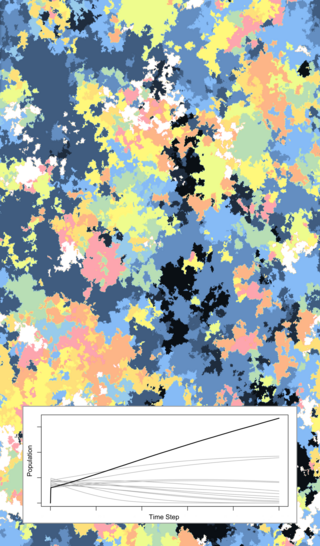
Microscale models form a broad class of computational models that simulate fine-scale details, in contrast with macroscale models, which amalgamate details into select categories. Microscale and macroscale models can be used together to understand different aspects of the same problem.
Cell-based models are mathematical models that represent biological cells as discrete entities. Within the field of computational biology they are often simply called agent-based models of which they are a specific application and they are used for simulating the biomechanics of multicellular structures such as tissues. to study the influence of these behaviors on how tissues are organised in time and space. Their main advantage is the easy integration of cell level processes such as cell division, intracellular processes and single-cell variability within a cell population.
References
- 1 2 3 4 An G, Mi Q, Dutta-Moscato J, Vodovotz Y (2009). "Agent-based models in translational systems biology". Wiley Interdisciplinary Reviews. Systems Biology and Medicine. 1 (2): 159–171. doi:10.1002/wsbm.45. PMC 3640333 . PMID 20835989.
- ↑ Politopoulos I (11 September 2007). "Review and Analysis of Agent-based Models in Biology" (PDF). Archived from the original (PDF) on 27 July 2011.
- ↑ García MR, Vázquez JA, Teixeira IG, Alonso AA (2018). "Stochastic Individual-Based Modeling of Bacterial Growth and Division Using Flow Cytometry". Frontiers in Microbiology. 8: 2626. doi: 10.3389/fmicb.2017.02626 . PMC 5760514 . PMID 29354110.
- 1 2 Perez L, Dragucevic S (2010). Exploring Forest Management Practices Using and Agent-Based Model of Forest Insect Infestations (PDF). 2010 International Congress on Environmental Modeling and Software. Ottawa, Canada: International Environmental Modeling and Software Society (iEMSs). Archived from the original (PDF) on 8 October 2015. Retrieved 25 July 2016.
- 1 2 Ameden HA, Boxall PC, Cash SB, Vickers DA (2009). "An Agent-Based Model of Border Enforcement for Invasive Species Management". Canadian Journal of Agricultural Economics. 57 (4): 481–496. doi:10.1111/j.1744-7976.2009.01166.x.
- 1 2 Evans A, Morgan D, Parry H (2004). Aphid Population Dynamics in Agricultural Landscapes: An Agent-based Simulation Model (PDF). 2010 International Congress on Environmental Modeling and Software. Osnabruck, Germany: International Environmental Modeling and Software Society (iEMSs). Archived from the original (PDF) on 6 October 2008. Retrieved 25 July 2016.
- 1 2 Li H, Mynett A, Qi H (2009). Exploring Multi-Agent Systems in Aquatic Population Dynamics Modeling. Proc. 8th International Conference on Hydroinformatics. Chile.
- ↑ Liang, Tong; Brinkman, Braden A. W. (14 March 2022). "Evolution of innate behavioral strategies through competitive population dynamics". PLOS Computational Biology. 18 (3): e1009934. doi: 10.1371/journal.pcbi.1009934 . ISSN 1553-7358. PMC 8947601 . PMID 35286315.
- ↑ BehaviorSpace Guide
- ↑ Osborne JM, Fletcher AG, Pitt-Francis JM, Maini PK, Gavaghan DJ (February 2017). "Comparing individual-based approaches to modelling the self-organization of multicellular tissues". PLOS Computational Biology. 13 (2): e1005387. Bibcode:2017PLSCB..13E5387O. doi: 10.1371/journal.pcbi.1005387 . PMC 5330541 . PMID 28192427.
- ↑ Metzcar J, Wang Y, Heiland R, Macklin P (February 2019). "A Review of Cell-Based Computational Modeling in Cancer Biology". JCO Clinical Cancer Informatics. 3 (3): 1–13. doi:10.1200/CCI.18.00069. PMC 6584763 . PMID 30715927.
- ↑ Rejniak KA (July 2007). "An immersed boundary framework for modelling the growth of individual cells: an application to the early tumour development". Journal of Theoretical Biology. 247 (1): 186–204. Bibcode:2007JThBi.247..186R. doi:10.1016/j.jtbi.2007.02.019. PMID 17416390.
- ↑ Newman TJ (2007). "Modeling Multicellular Structures Using the Subcellular Element Model". Single-Cell-Based Models in Biology and Medicine. Mathematics and Biosciences in Interaction. Basel: Birkhäuser Basel. pp. 221–239. doi:10.1007/978-3-7643-8123-3_10. ISBN 978-3-7643-8101-1 . Retrieved 4 April 2022.
- 1 2 Lardon LA, Merkey BV, Martins S, Dötsch A, Picioreanu C, Kreft JU, Smets BF (September 2011). "iDynoMiCS: next-generation individual-based modelling of biofilms". Environmental Microbiology. 13 (9): 2416–2434. doi:10.1111/j.1462-2920.2011.02414.x. PMID 21410622. S2CID 19524967.
- ↑ Wanner O, Eberl H, Morgenroth E, Noguera D, Picioreanu C, Rittmann B, van Loosdrecht M (2006). Mathematical Modeling of Biofilms. London: IWA Publishing.
- ↑ Merkey BV, Lardon LA, Seoane JM, Kreft JU, Smets BF (September 2011). "Growth dependence of conjugation explains limited plasmid invasion in biofilms: an individual-based modelling study". Environmental Microbiology. 13 (9): 2435–2452. doi:10.1111/j.1462-2920.2011.02535.x. PMID 21906217.
- ↑ Steffens MJ, Clement BJ, Wentworth CD (2011). Individual-based Modeling of a Pseudomonas aeruginosa Biofilm with Glucose Substrate. Fall 2011 Meeting of the APS Prairie Section, November 10–12, 2011, abstract #E1.006. American Physical Society.
- ↑ Nguyen DH, Oketch-Rabah HA, Illa-Bochaca I, Geyer FC, Reis-Filho JS, Mao JH, et al. (May 2011). "Radiation acts on the microenvironment to affect breast carcinogenesis by distinct mechanisms that decrease cancer latency and affect tumor type". Cancer Cell. 19 (5): 640–651. doi:10.1016/j.ccr.2011.03.011. PMC 3110779 . PMID 21575864.
- ↑ Preston DL, Mattsson A, Holmberg E, Shore R, Hildreth NG, Boice JD (August 2002). "Radiation effects on breast cancer risk: a pooled analysis of eight cohorts". Radiation Research. 158 (2): 220–235. Bibcode:2002RadR..158..220P. doi:10.1667/0033-7587(2002)158[0220:reobcr]2.0.co;2. PMID 12105993. S2CID 30505427.
- ↑ Mertens AC, Liu Q, Neglia JP, Wasilewski K, Leisenring W, Armstrong GT, et al. (October 2008). "Cause-specific late mortality among 5-year survivors of childhood cancer: the Childhood Cancer Survivor Study". Journal of the National Cancer Institute. 100 (19): 1368–1379. doi:10.1093/jnci/djn310. PMC 2556702 . PMID 18812549.
- ↑ Tang J, Fernandez-Garcia I, Vijayakumar S, Martinez-Ruis H, Illa-Bochaca I, Nguyen DH, et al. (March 2014). "Irradiation of juvenile, but not adult, mammary gland increases stem cell self-renewal and estrogen receptor negative tumors". Stem Cells. 32 (3): 649–661. doi: 10.1002/stem.1533 . PMID 24038768. S2CID 32979016.


